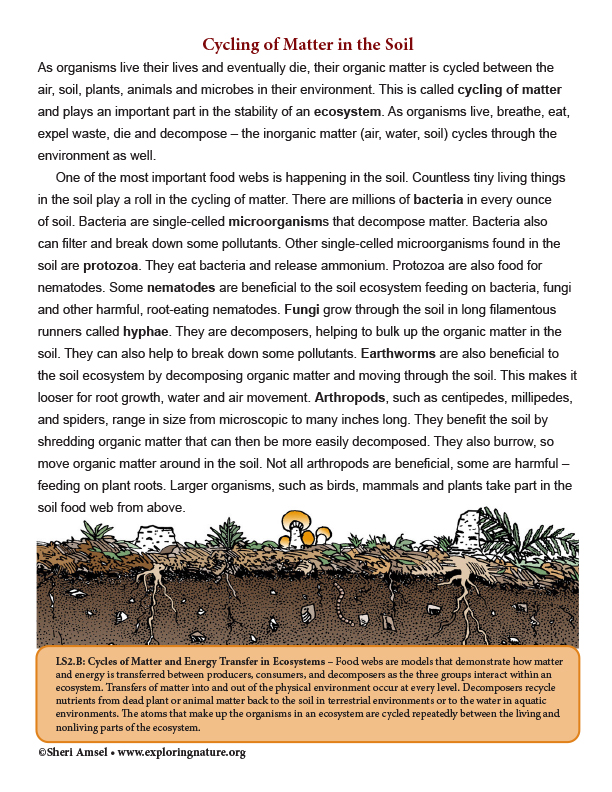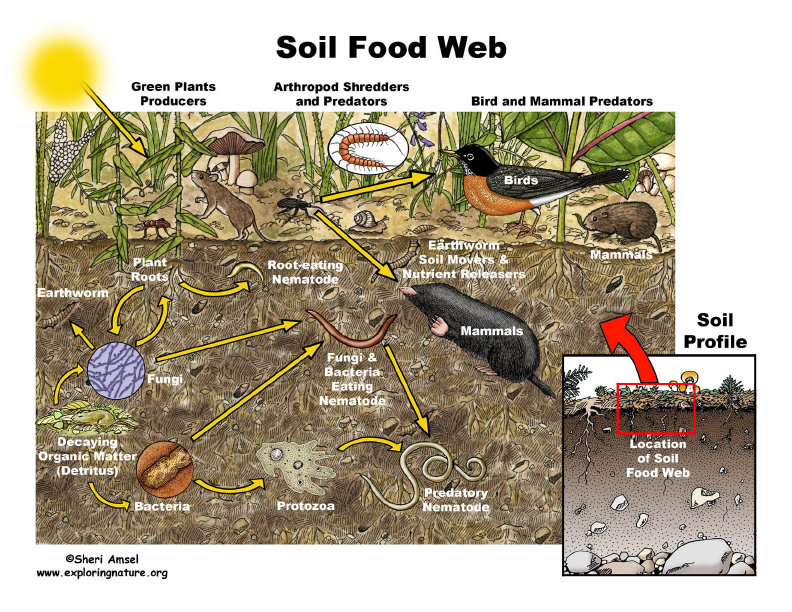

As organisms live their lives and eventually die, their organic matter is cycled between the air, soil, plants, animals and microbes in their environment. This is called cycling of matter and plays an important part in the stability of an ecosystem. As organisms live, breathe, eat, expel waste, die and decompose – the inorganic matter (air, water, soil) cycles through the environment as well.
One of the most important food webs is happening in the soil. Countless tiny living things in the soil play a roll in the cycling of matter. There are millions of bacteria in every ounce of soil. Bacteria are single-celled microorganisms that decompose matter. Bacteria also can filter and break down some pollutants. Other single-celled microorganisms found in the soil are protozoa. They eat bacteria and release ammonium. Protozoa are also food for nematodes. Some nematodes are beneficial to the soil ecosystem feeding on bacteria, fungi and other harmful, root-eating nematodes. Fungi grow through the soil in long filamentous runners called hyphae. They are decomposers, helping to bulk up the organic matter in the soil. They can also help to break down some pollutants. Earthworms are also beneficial to the soil ecosystem by decomposing organic matter and moving through the soil. This makes it looser for root growth, water and air movement. Arthropods, such as centipedes, millipedes, and spiders, range in size from microscopic to many inches long. They benefit the soil by shredding organic matter that can then be more easily decomposed. They also burrow, so move organic matter around in the soil. Not all arthropods are beneficial, some are harmful – feeding on plant roots. Larger organisms, such as birds, mammals and plants take part in the soil food web from above.
When you research information you must cite the reference. Citing for websites is different from citing from books, magazines and periodicals. The style of citing shown here is from the MLA Style Citations (Modern Language Association).
When citing a WEBSITE the general format is as follows.
Author Last Name, First Name(s). "Title: Subtitle of Part of Web Page, if appropriate." Title: Subtitle: Section of Page if appropriate. Sponsoring/Publishing Agency, If Given. Additional significant descriptive information. Date of Electronic Publication or other Date, such as Last Updated. Day Month Year of access < URL >.
Amsel, Sheri. "Cycling of Matter in the Soil (6-8 Grade NGSS)" Exploring Nature Educational Resource ©2005-2024. December 14, 2024
< http://www.exploringnature.org/db/view/Cycling-of-Matter-in-the-Soil-6-8-Grade-NGSS >

